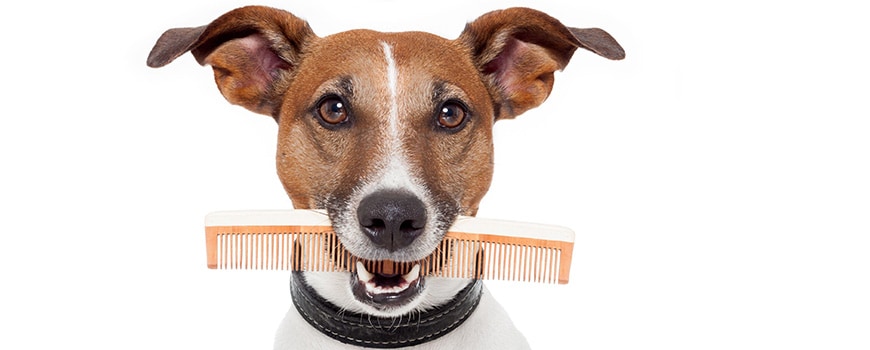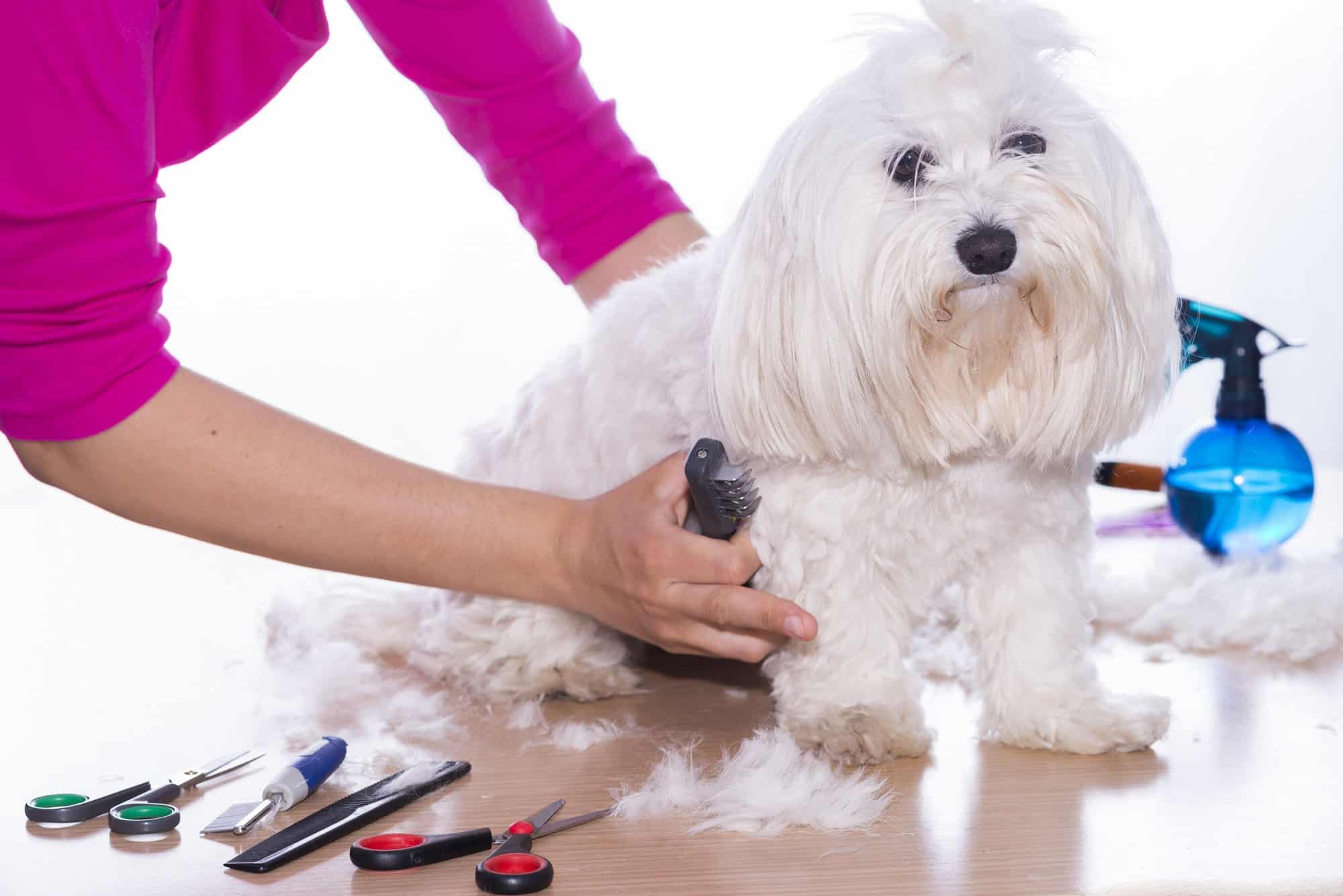In the process of grooming, unfortunately you can always expect to injure your dog at some point. You can nick your dog
in any area of her body if you aren’t careful about using the correct blades. In sensitive areas such as the groin, stomach, armpits, and rear, you need to be very careful to use blades with teeth that are very close together, and to pull the skin very taut before you begin clipping.
If you nick an area of skin, first assess how large the wound is and apply pressure with a paper towel or gauze to stop the bleeding.
Stop the Bleeding
While cutting that tiny mat behind the ear, you accidentally pulled up some skin and sliced it open! If you’re lucky, it won’t bleed. Nevertheless, you should try to close the cut temporarily with a surgical glue called Nexaban until the veterinarian can examine it.
Your veterinarian can order Nexaban for you. Put a drop into the wound, pinch the skin back to its normal position, and hold it for three seconds. No Nexaban? In a pinch, super glue does wonders, but it can hurt. Be careful not to glue hair inside the wound and watch that you don’t glue your fingers to the pet’s skin.
The veterinarian may decide a few stitches are necessary, but sometimes the glue will be all that’s required. It’s a good idea to call your veterinarian for advice about using the glue or stopping any bleeding. If there is a lot of bleeding, go directly to the vet, do not pass go, and get ready to pay for stitches.
If there is significant bleeding, direct pressure to the cut will stop the flow as long as you keep up the pressure. You can apply styptic gel or styptic powder to the wound or use a silver nitrate stick on it. Then, just when you thought you had the bleeding stopped, you put the dog in a crate to call the vet and he shakes and the bleeding starts all over again. You look inside the cage and it looks like a scene from a horror movie!
Hydrogen peroxide works great to remove blood, but it can bleach out colors if it is left too long. Do not use hydrogen peroxide on the wound because it will dissolve the clot.
If the cut is on the earflap, put pressure on the wound again and stop the bleeding, then fold the ear over the top of the head and wrap rolled gauze and vet wrap around the dog’s head to prevent the ears from flapping as he shakes. Vet wrap is sort of like an Ace bandage that sticks to itself, only it’s lighter and stretchy. Be sure not to pull it too tight, or it can act as a tourniquet.
The idea is to prevent the ears from flapping around, not to prevent the dog from breathing. Another easy way to wrap the dogs head is to take a knee-high ladies stocking or leg from panty hose, cut off the toe end and stretch it over the dogs head to hold the ears in place and prevent them from flapping around if your dog shakes his head.
Always look to see the tips of your shears when you are cutting hair. It’s a habit to look where your shears start to cut, but if you aren’t paying attention, you can nick other parts of your dog with the scissor tips.
Ears
Always clip in the direction of hair growth—toward the edge of the ear—on both sides of the ear, but never use your clippers down the edge of the ear as you would use scissors. This area is notorious for nicks. Be sure to have a good grip on the earflap—one sudden move from the dog and you’ll have a nick.
If you are using scissors to trim the ear’s edge, use your fingers as a guide. Brush up the hair you want to remove and hold the earflap firmly between your fingers to prevent nicking the ear.
Tongues
You know the type of dog. She constantly licks her nose, and as you are oh-so-carefully trimming the hair around her mouth, her tongue darts out and just barely touches your shears. You may not realize what happened—and neither may the dog—but before long, the dog licks her nose once again and you notice her muzzle is red!
Here is a hint to prevent a dog from opening her mouth while you are trimming around it. Blow on her nose, and she will close her mouth. It may be only for a second, but that may be long enough for you to trim the hair where you need.
Tongues are a hard place to stop bleeding. If it’s just a little nick or graze, get out the ice cream or popsicles for your dog to give him something very cold to lick to slow the bleeding. You could also let the dog bite on a teabag; the tannic acid in the teabag helps to slow the bleeding. If the cut is more extensive, it’s time to go see the vet.
Be sure to hold the dog’s muzzle closed. If a dog gets a good lick on your sharp shears, he can cut his tongue seriously.
Tails
Be careful when using your shears to split matting, especially on a tail. A dog can wiggle the end of her tail directly into your path, and you can nick the end of her tail. The dog may be oblivious to any pain and continue to wag her tail, sending blood spatter all over the place.
Don’t use a dry paper towel to hold pressure; dampen the paper towel first. A dry towel will adhere to the wound, and when you take the paper towel off, it will reopen the wound. A wet towel won’t do that.
This type of wound requires compression to stop the bleeding. Hold pressure on the wound until it clots. If it’s just a nick, you can probably handle it with styptic powder, styptic gel, or a silver nitrate stick. If it’s more extensive, off to the vet with you.
Dewclaws
Always be aware of where on the leg your dog’s dewclaws are. It’s very easy to accidentally nick or cut the dewclaws, especially the ones on the hind legs that are usually loose and floppy and hiding under hair. Feel around each leg for dewclaws before you scissor or clip the leg to prevent an accident.
Quicking a Nail
It’s very easy to quick a nail, especially black nails where you can’t see the quick. Add to that a dog that jerks its foot, and you have a recipe for a boo-boo. Quicked nails do hurt and can bleed quite a bit. If you quick a nail, take a damp paper towel and apply pressure to the cut part of the nail for a few minutes.
If that doesn’t stop the bleeding, take a pinch of styptic powder and pack the end of the nail with that and hold pressure on it for a few more minutes. The bleeding should stop.
Another way to fix a quicked nail is to use silver nitrate sticks. You take the end of the stick with the medicine on it and dip it in water—just enough to wet it briefly—then apply it with some pressure to the cut area. You can use a scraping motion to get the medicine on the wound. Silver nitrate does burn, so expect the dog to put up a fuss, but it will clot the bleeding quickly. Most wounds won’t need more than one or two silver nitrate sticks.
Many show dogs have their nails trimmed often in order to get the quick to recede so you can trim their nails short. Some show people will have a veterinarian sedate or anesthetize the dog in order to cut the nail short and cauterize the cleaned and scrubbed nail to inhibit bleeding.
What if the dog’s nail snagged something and it broke off at the base, but now it is just hanging there? In this case, you have to remove the nail. Usually, you can grab the broken nail with hemostats or your fingers, and the dog will inevitably jerk her foot and the nail will come off.
Sometimes, you may need to use nail trimmers and cut it off, trying hard not to cut the quick underneath the broken nail. Will it hurt? Yes, so be quick about it. Will it bleed? Probably, so be prepared with styptic powder. It’s not pleasant, but it happens.
Sometimes you have to be the bad guy and finish the job. Don’t worry; it will hurt a lot less after the nail is gone. Keeping your dog’s nails short and filed generally prevents this from happening. Keep an eye out for a potential infection at the base of the nail, too. A broken nail can lead to an infected toe in a worst-case scenario.
Styptic powder makes a scab over the wound, but the dog can scratch it off while walking and it can start to bleed again. If you don’t have styptic powder, any powder will do in a pinch—flour, baking soda, baking powder, or cornstarch. Even rubbing the cut nail on a wet bar of soap will help clot the wound.


